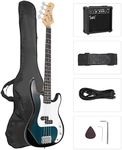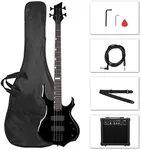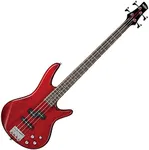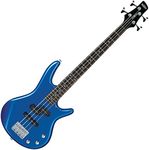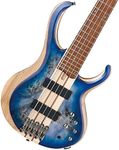Buying Guide for the Best Cheap Bass Guitars
Choosing the right bass guitar can be a rewarding experience, especially if you're looking for an affordable option. It's important to consider several key specifications to ensure you get the best instrument for your needs. By understanding these specs, you can make an informed decision and find a bass guitar that suits your playing style and preferences.Body MaterialThe body material of a bass guitar affects its tone and weight. Common materials include alder, basswood, and mahogany. Alder is known for its balanced tone, basswood for its light weight and warm sound, and mahogany for its rich, deep tones. If you prefer a lighter instrument, basswood might be the best choice. For a more balanced sound, alder is a good option, while mahogany is ideal for those seeking a deeper, warmer tone.
Neck TypeThe neck type influences the playability and comfort of the bass guitar. There are bolt-on, set-neck, and neck-through designs. Bolt-on necks are common in affordable basses and offer a snappy response. Set-neck designs provide better sustain and a smoother transition between the neck and body. Neck-through designs offer the best sustain and stability but are usually found in higher-end models. For beginners, a bolt-on neck is often sufficient and provides good playability.
Scale LengthScale length refers to the distance between the nut and the bridge. Common scale lengths are 34 inches (standard) and 30 inches (short scale). A standard scale length provides a tighter string tension and a more defined tone, suitable for most playing styles. Short scale basses have less string tension, making them easier to play, especially for those with smaller hands or beginners. Choose a scale length that feels comfortable and suits your playing style.
PickupsPickups are crucial for the sound of an electric bass guitar. There are single-coil and humbucker pickups. Single-coil pickups offer a bright, clear tone but can be prone to noise. Humbuckers provide a thicker, warmer sound and are less noisy. Some basses come with a combination of both. If you play rock or metal, humbuckers might be more suitable. For funk or jazz, single-coils can offer the clarity you need. Consider the genre of music you play when choosing pickups.
Number of FretsThe number of frets on a bass guitar affects its range. Most bass guitars have 20 to 24 frets. More frets provide a wider range of notes, which can be useful for soloing and playing higher melodies. However, fewer frets can make the neck easier to navigate, which is beneficial for beginners. If you plan to play complex solos, a bass with more frets might be ideal. For simpler playing, fewer frets can be more comfortable.
Bridge TypeThe bridge type affects the sustain and tuning stability of the bass guitar. Common types include fixed and adjustable bridges. Fixed bridges are simpler and provide good sustain and stability, making them a good choice for beginners. Adjustable bridges allow for more precise intonation adjustments, which can be beneficial for advanced players. If you're just starting out, a fixed bridge is usually sufficient and easier to maintain.


